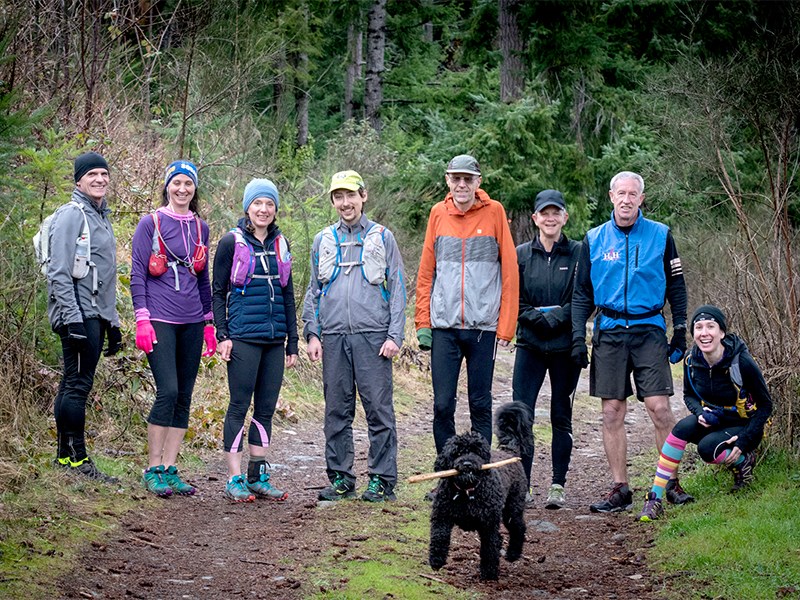More than 500 trails zigzag across the varied terrain of the Upper Sunshine Coast, the majority of which are unauthorized and created under the cover of semi-anonymity. Powell River’s trail system has existed, as have those in many other communities on the coast, in a grey zone of land use. But that system may be in for a change.
According to Powell River Outdoor Recreation Users Group (ORUG) past president Pat Walsh, Powell River’s trails exist despite official recognition and management.
“If we did that in spite of the system, just think about what we could do if the system was working to our benefit,” said Walsh.
Last year, according to documents from ORUG, volunteers put in more than 8,000 hours of labour to clean up trails after storms and cut back growth to groom them.
Powell River is not alone in its recognition that trails are and have been an unrecognized community asset, not only for enhancing quality of life for current residents, but also for developing them to make it easier for out-of-town visitors to access and appreciate.
As Powell River transitions away from its mill-town economy, many residents are hanging their hopes for the region’s future on placing its outdoors at the centre of the local economy.
Those hopes are reflected in the regional trails plan developed last year for Powell River Regional District. In 2016, the regional district contracted master plan consultants to create a trails plan that would assist in that transition.
According to the plan’s final draft, it is important to recognize the economic potential a strong trail network has in drawing tourists.
The plan also states that trails have been shown to contribute to the social development of a community and education of its residents, as well as having a positive impact on the environment and drawing recreational events to the region.
So what are Powell River’s trails worth?
“That’s the million-dollar question,” said Sunshine Coast Tourism executive director Paul Kamon.
Kamon said Sunshine Coast Tourism is looking to partner with Tourism Vancouver Island to define and identify the economic impacts of trails on Vancouver Island, the Gulf Islands and the Sunshine Coast. Tourism Vancouver Island released its hiking-tourism master plan last August. Kamon said that after identifying trails, the next step is to try to quantify their economic impact.
“This will help us to be able to speak with government in a way they can understand and appreciate,” he said. “They are the ones making the economic decisions.”
In 2014, Squamish was asking the same question, as it had witnessed an explosion of growth in mountain bikers visiting the community to access its volunteer built and maintained trails.
To try to quantify that, Squamish Off-Road Cycling Association commissioned a report and found trail traffic had quadrupled since 2006, the last time a similar survey had been completed.
Squamish’s trail infrastructure was worth roughly $8 million in economic spinoffs, including accommodations, restaurants and bicycle industry-related purchases.
Kamon said Powell River is looking at developing more international marketing that highlights the region’s diversity of outdoor activities.
“We want to be a high-value boutique destination that’s very embracing of cultures and peoples and be very respectful of other communities,” he added.
In the meantime, continued promotion of Powell River by the annual BC Bike Race, and work by Powell River Parks and Wilderness Society (PRPAWS), has further raised the region’s profile internationally as a place for world-class hiking and mountain biking, said Regional Trail Network Chair’s Standing Committee (RTNCSC) member Wayne Brewer in his remarks to the regional board’s committee of the whole meeting Thursday, March 16.
“Sunshine Coast Trail and mountain biking is going to get busier and busier,” said Brewer after the meeting. “The time to get ready for that is now, before it’s on us.”
Brewer and Walsh, both members of the now completed RTNCSC, said it is time to start making incremental progress in having trails recognized and maintained with the involvement of local government. The committee was established in January after PRPAWS raised concerns that it did not have enough input in the plan.
At the March 16 meeting, PRPAWS president Eagle Walz said that after having the opportunity to make presentations and have discussions with the chair’s standing committee, PRPAWS no longer has concerns that its efforts to promote the Sunshine Coast Trail as a premier hiking route will be undermined by the local government promoting it as a trail for mountain biking.
Walz said PRPAWS understands and appreciates what other outdoor users groups are attempting to do with trails and can play a role in helping out.
At the same meeting, Walsh presented the standing committee’s three recommendations for the regional government to implement the trails plan.
“A considerable amount of input has gone into the Regional Trails Plan,” said Walsh. “While it’s not perfect, it is an excellent guiding document.”
The standing committee is recommending the regional board accept the trails plan, establish a new standing committee and hire a trails coordinator. It is also recommending the regional district provide liability insurance for volunteers who participate in community-organized trail building and maintenance.
Walsh said he believes that if the plan was accepted without the creation of a new committee, or without hiring a coordinator, it would be doomed to sit on a shelf at the regional district and gather dust.
Once the regional board accepts the plan, it will be up to the board to create a job description for the trails coordinator position, said chair Patrick Brabazon, and create the terms of reference for the standing committee.



